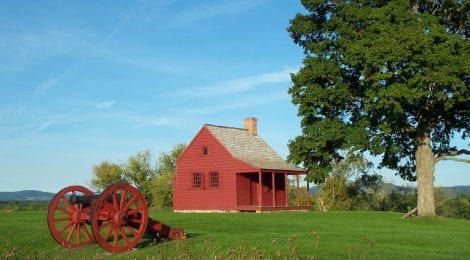
Saratoga Battlefield: Upstate New York’s local history
The Saratoga Battlefield was the site of multiple battles during the American Revolution in 1777, which culminated in a decisive American victory on October 17th, 1777. The battles are often hailed as the “turning point” of the war. The second battle at Saratoga is also notable for being won by Benedict Arnold, who would eventually turn coat because he felt underappreciated by the American generals and leaders, becoming the most famous traitor in American history. However, his victory at Saratoga was crucial in gaining foreign support for the American cause, and in the eyes of some, affirmed the American Revolution as a legitimate cause to the rest of Europe. Saratoga Battlefield is also important to me as a history site local to my own area of Upstate New York. It is our little historical claim to fame, having an important Revolutionary War battlefield only 40 minutes from my home.
The Saratoga National Historical park is made up of the Saratoga Battlefield, which houses an information center and museum, a driving tour, and various hiking trails, and the Phillip Schuyler house, down the road. There is also the Saratoga Battlefield monument, which is an obelisk similar in design to the Washington monument and the lesser-known monument in Bennington, Vermont. It commemorates the battles and the key figures in them. They are owned and maintained by the National Parks Service. The museum has various exhibits on the battle and key figures in it, featuring letters, paintings, artifacts, and replicas of various people and objects. It also, like many other museums of its kind, has a small theater showing informational documentary-like films on the history of the site.
The Phillip Schuyler house is included within park grounds, but is separate from the museum complex about 8 miles down the road and can be reached by car. Phillip Schuyler and his family have once again entered the public eye in recent years with the popularity of the Broadway musical Hamilton, in which his daughters Angelica and Eliza Schuyler are key figures. The house has been much preserved and features a house tour that showcases the lower and upper floors of the house, along with the grounds and the servants’ quarters. Tour guides give anecdotes about Phillip Schuyler’s time in the house during the time of the Revolution and afterward when he paid English soldiers to repair it for him.
Aside from the museums and hiking, the park also hosts many events for various patriotic holidays and important dates during the Revolution. Many of their events involve re-enactments; local reenacting groups converge upon the site during October to act out the events of the famous battles, often inviting museum-goers and people taking tours to join them in the battle. In some cases, the American “soldiers” will warn you as you pass their line that you are passing into “enemy territory,” which adds a sense of immersion in the history of the place. And people take a lot of pride in their regiments and the history that they’re reenacting, as many people in the area grew up learning all about it.
One of the aforementioned hiking trails is known as Victory Woods, which is where Burgoyne (the British General commanding at the second battle at Saratoga) and his troops camped for a week before their surrender to the American forces on October 17th. The trail is accessible, with a wooden pathway and various signs with information on the area and the battles. Also onsite is the Neilson house, which belonged to John Neilson who farmed on the land that became the battlefield both before and after the battles. It is also preserved, as the Schuyler house is, although it is much smaller. The Saratoga Historical Park is meant to make history accessible and easily digestible to anyone looking to immerse oneself in their local history and it succeeds in this through many different avenues.